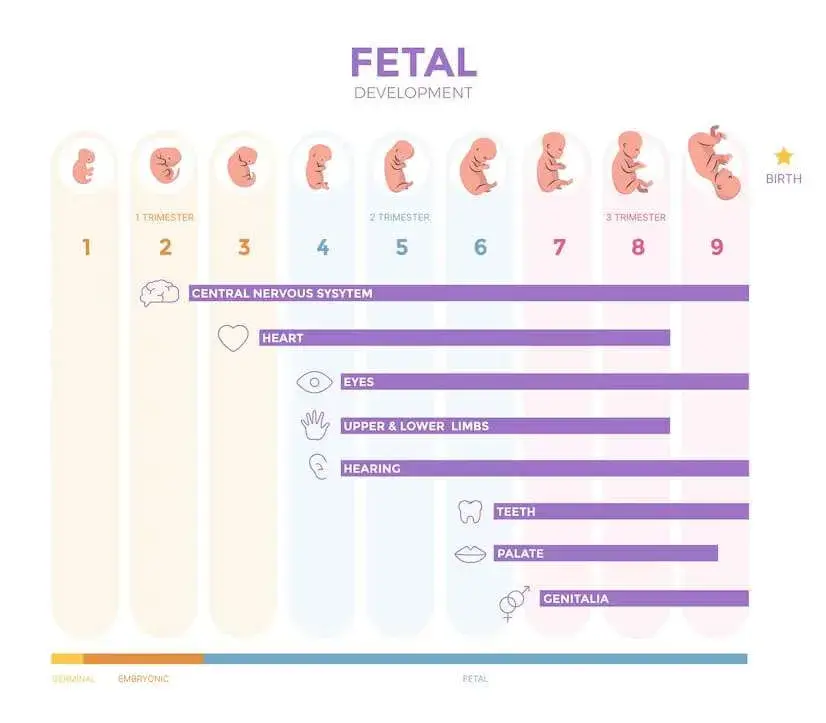The baby that grows into your ovum quickly develops into many cells within 24 hours of fertilization. The embryo grows into a fetus during the 8th week of pregnancy. A typical pregnancy lasts roughly 40 weeks. The stages of development of the fetus encompass distinct periods, beginning with the embryonic stage, where major organs and structures form, followed by the fetal stage, where growth and refinement occur, ultimately leading to the fully developed fetus ready for birth.
This period is separated into three trimesters. Fetal development is divided into germinal, embryonic, and fetal stages. In this article, we will look into the beautiful journey of the development of the fetus in all stages, so continue reading to know all stages and how your baby grows.
What are the Stages of Development of the fetus?
 There are three main stages of the Development of a Fetus.
There are three main stages of the Development of a Fetus.
1. Germinal stage -
This stage of fetal development is the shorte'st. It all starts with conception when a sperm and an egg combine inside your fallopian tube. The sperm fertilizes the egg, resulting in the formation of a zygote. Over roughly a week, the zygote makes its way down to your uterus. The zygote divides numerous times during this voyage, eventually becoming two distinct structures. One component develops into the embryo, while the other develops into the placenta.
Cell division is continuing apace. The zygote eventually develops into a blastocyst. The blastocyst comprises three distinct parts, each growing into a unique structure inside the body. The blastocyst enters your uterus and inserts itself into the uterine lining. If the placement goes well, your body will start creating hormones to support the pregnancy. This also ends your menstrual cycle.
2. Embryonic stage -
The embryonic phase lasts approximately from the third to the 8th week of pregnancy. The embryonic cell begins to develop human traits. It's now known as an embryo. The neural tube develops, which eventually turns the brain, spinal cord, head, eyes, mouth, and limbs form. Around the sixth week, the embryo's heart begins to grow and pulse.
Around the sixth week, lobes that will become limbs and legs begin to grow. Most of the embryo's organs and systems have formed at the finish of the eighth week. Many women have morning sickness at this phase in their pregnancy.
Book an Online Appointment at the Best Fallopian Tube Surgery Hospitals in India
3. Fetus Stage -
The fetal development period begins in the ninth week of pregnancy and continues until birth. This is the stage at which the embryo becomes a fetus. During the 9th week of pregnancy, the fetus receives its allocated sexuality, though your healthcare professional cannot identify it on ultrasound.
The fetus's key organs and bodily systems continue to develop and mature. Fingernails, eyelashes, & hair are a few things that grow. While the developing baby can move its limbs, you may not see this till the twentieth week of pregnancy. Most growth, including size and length, occurs during the fetal stage.
Stages of Development being Pregnant Month by Month
During an ordinary pregnancy, the fetus will undergo significant changes. This period is broken into three stages known as trimesters. Each trimester lasts around three months. Through the various stages of the pregnancy, you will observe different changes in both the fetus and yourself.
1. The first trimester -
During development for 12 weeks, the initial trimester will last. This usually occurs throughout the earliest 3 months of pregnancy.
-
Month 1 (weeks 1-4)
Your body gradually produces more hormones, and the womb prepares for a possible pregnancy. The fertilization process occurs within the 3rd week. A zygotic cell is formed when a sperm and an egg combine. The little bundle of cells develops into a blastocyst sac and inserts itself into your uterus lining. The embryonic form of the placenta is formed. Surrounding the center of the blastocyst, a protective sac forms.
-
Month 2 (weeks 5-8)
Most women discover they are pregnant around the next month of their pregnancy. The tube neural (brain, spinal cord, and other neural cells of the central neural tract) develops. The legs and arms grow. Blood cells are forming, and transportation will begin. The structures that will become the ears, eyes, and mouth take shape.
Bones begin to replace spongy cartilage, and genitals develop. The embryo's head is enormous compared to the other parts of its skeletal structure. The main organs and bodily systems are developing. Eyes appear, and ears develop. The umbilical tube is fully grown and aids in delivering blood flow and oxygen to the embryo.
-
Month 3(weeks 9-12)
During the 3rd month of pregnancy, an embryo develops into a fetus. This is a time of fast growth and progress. The first teeth and sense of taste are developing. Its muscles are developing, and the shape of its body is becoming more human-like. The arms, hands, fingers, feet, and toes have finished developing (no longer webbed fingers).
The fetus begins exploring a little by opening and shutting its hands and lips. The bones are becoming harder, and facial characteristics are becoming more noticeable. All organs, limbs, bones, and skeletal muscles have been developed and are ready to function.
Also Read: Tests During Pregnancy First Trimester
2. The second trimester -
You may also feel movement when the fetus flips and spins in your uterus. Many people learn about the fetus's gender during this trimester.
-
Month 4 (week 13-16)
A Doppler ultrasound can detect the fetal heartbeat. The fetus might suck its thumb, murmur, stretch, and make faces. The fetus's huge head expands in proportion to its body and throat form. The fetus's skin starts getting thicker, and hair that is fine begins to grow.
It can move its thumbs to its oral cavity and swivel its head. The fetus begins to move with greater intent, such as biting its thumb or smirking. The fetus has lips and ears mature enough to hear you speak. Even with closed eyes, the fetus can respond to brightening by turning away.
-
Month 5 (week 17-20)
You'll have your first ultrasound. You might even get to learn the fetus's gender. The fetus still has pale skin but will begin gaining weight. It has a whitish coating on its skin called vernix. The fetus is coated in lanugo, which looks like peach fuzz.
It aids in keeping the fetus warm and adds a layer of protection.The fetus grows stronger, and most individuals start feeling kicks and punches. The fetus's nails reach the tips of its fingers. The nervous system is responsible for every sense that begins to grow.
-
Month 6 ( week 21-24)
Its eyelid begins to part in the 6th month of pregnancy, and you may detect regular, jerky movements. The fetus moves or increases its pulse in response to sounds. Controlled and frequent movements of the limbs. The fetus possesses bone marrow, which aids in the production of blood cells. The fetus' grasp is strengthening, and can now feel its ears and umbilical cord.
It can detect your heartbeat, stomach rumble, and respiration. If a baby is born prematurely, it may survive after its twenty-third week with careful care. It will begin quickly gaining weight. The fetus's lungs have fully matured but not sufficiently to function outside your uterus
-
Month 7 ( week 25-27)
The fetus continues to develop and store body fat reserves. The fetus moves about regularly and reacts to stimuli like sound, pain, and light. Increased body fat makes the fetus's skin wrinkle and plumper. Its neurological system is rapidly developing. The fetus produces melanin, the pigment that gives eyes and skin color.
After birth, the fetus's lungs produce surfactant, a chemical that aids breathing. After these different stages of development of the fetus, it can open its eyes and blink. It also has lashes on its eyes. As the fetus prepares for birth, it may begin to turn head-down in your uterus and grow around three pounds at the close of the 7th month of pregnancy.
Also Read: Second Trimester of Pregnancy - Weeks 13 to 28
3. The third trimester
During the 3rd trimester, the fetus rapidly acquires weight, accumulating body fat that will be useful after birth.
-
Month 8( week 29-32)
The majority of internal systems are mature. However, the respiratory system can remain immature. The movements and jabs could seem more like hits now that the fetus is constricted in the sac of amniotic fluid. The fetus can regulate its body temperature. Its brain is rapidly maturing and increasing. Except for the respiratory and nervous systems, most other body parts are complete and ready for delivery by week 32.
-
Month 9 (weeks 33-36)
At this point in pregnancy, the lungs are almost fully grown. The fetus's bones are strengthening, with some exceptions of its brain's activity, which must remain soft to pass through the birth canal. The vernix, which covers the fetus's skin, thickens. The fetus's brain grows but still weighs around two-thirds of what it should at maturity. The fetus has fur on its forehead and has lost its lanugo.
Conclusion -
Pregnancy requires a lot of things to occur, grow, and result in a birth. When you consider how many organs, systems, and bodily functions increase throughout a nine-month pregnancy, understanding the stages of development of the fetus can be fascinating and eye-opening. During pregnancy, both you and the developing fetus undergo many changes. Every stage of the fetus's growth is important; every mother should know about this.
Book an Online Appointment with the Best Pregnancy Test Doctors Available in India

Reviewed by







